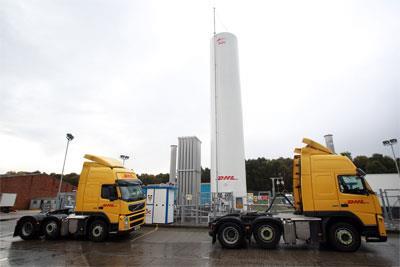
DHL Supply Chain’s Consumer division has become the latest – and among the biggest – investor in gas-powered trucks with the replacement of most of its 70-strong fleet based at its multi-user DC at Bawtry near Doncaster, south Yorkshire, with Volvo FM MethaneDiesel dual fuel 6x2 tractor units.
The large scale trial of 63 dual fuel liquid natural gas (LNG) technology is part of DHL’s Go Green initiative to cut CO2 emissions by 30% between 2007 and 2020; it estimates tank to wheel emissions reductions of 12% to 14% depending on how much diesel is substituted by gas.
The move is not entirely altruistic – the cost of converting the trucks and the installation of a BOC gas fuelling station is expected to be paid back within two to three years of the five year lease term because of the lower price of LNG compared with diesel.
David McDonald, vice president, operations, consumer and life sciences, says: “At 1m sq ft Bawtry is by far the largest site in the consumer and life sciences division. All our customers are interested in our environmental impact and a key driver is customer retention.”
According to Ian MacAulay, DHL innovation manager, fleet engineering services, LNG appears to be the best technology for reducing carbon emissions from the heavy truck fleet.
“We have tried biodiesel, electric and hybrid vehicles and better aerodynamics,” he says. “The Teardrop is an icon within our fleet – we own 1,000 and operate another 400 for customers. But gas is now a core focus for us. A lot of the low hanging fruit – vehicle specs, operational improvement etc – has now been picked. Dual fuel is the best option – there are doubts over the fuel savings from 100% gas spark ignition engines.”
DHL Supply Chain operates 7,500 trucks and 10,000 trailers in the UK, and 87% of its CO2 emissions come from the road fleet. Bawtry is among DHL’s top 10 carbon emitting sites, with carbon footprint estimated at 9,000 tonnes a year, 90% of which comes from its road fleet. The move to dual fuel will cut this annual output by 1,200 tonnes. “That is a significant dent,” says MacAulay.
DHL chose to work with Volvo because the dual fuel conversion is done at the factory and has been developed to maximise diesel substation, put at 60% to 75% depending on driving patterns. The vehicles have a 100kg LNG tank on the left and a 200l diesel tank on the right – the AdBlue tank has been relocated inboard to make room – giving a range of 650kms on gas/diesel mix and another 150kms on diesel alone. The new trucks are all Euro-5s – Volvo cannot say when it will have a Euro-6 dual fuel vehicle available.
LNG was chosen over compressed natural gas (CNG) because LNG is 2.4 times denser than CNG and so the vehicle tank is smaller. Some operators have struggled to get CNG tanks of adequate size onto a 6x2 unit, leaving them the choice of a small range or dropping to a 4x2 unit.
The BOC gas refuelling station has a 29t tank and has been designed to leak no gas to atmosphere – methane is 25 times worse than carbon dioxide in terms of its greenhouse effect, so leaking just 3% negates the environmental benefits of LNG. LNG is delivered by tanker and stored at -160C, with liquid nitrogen used to cool the tank and ensure no gas boils off. BOC LNG business manager Mark Lowe says vapour from hot vehicles tanks can also be captured and reliquefied during refuelling to avoid venting methane to the atmosphere.
The trucks will be double shifted and return to Bawtry at the end of each shift for refuelling, so range should not be a problem, says MacAuley. “We would prefer to use a quality gas refuelling network across the UK but where we have the scale we will go with our own station,” he says. “By the end of the year we will have three gas stations on DHL sites – Bawtry, Scunthorpe and Droitwich.”
Across the UK, DHL now operates over 100 dual fuel trucks and while it has no plans to open up its gas stations to third parties it will be able to refuel its other gas vehicles at Bawtry.














![Logistics North East 1[73400]](https://d2cohhpa0jt4tw.cloudfront.net/Pictures/100x67/6/5/9/17659_logisticsnortheast173400_443720.jpg)